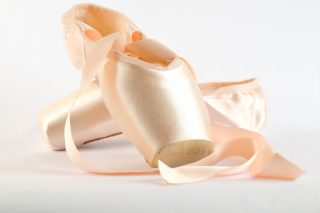Ballet Shoes, Dance Surface & Foot Injury

Written by Michelle Champlin BSc Pod., M.Ch.S., S.R., Ch., (UK)
Traditional ballet shoes can break down and wear out after just one performance. The shoes are handmade of satin and ribbon. The shoe affords some shock absorption by having a stiff cardboard midsole, cotton insole and a stiff cardboard outsole. The tip of the shoe is glued canvas that enables dancing on full pointe. Injuries may occur when the ballet shoes have worn out. Sometimes, the shoe may collapse, causing the dancer’s foot to roll over when en pointe, risking ankle sprain.
Dance surfaces must provide enough shock absorption yet also be firm enough to provide energy return to the dancer to reduce fatigue. Surfaces that are too firm with little or no give (e.g. concrete) may lead to early muscular fatigue. Once this system fails to absorb shock adequately, afflictions of the feet (e.g. stress fractures) may follow. On the other hand, if a dance surface is too soft, this too can lead to early fatigue. In this situation, there is adequate absorption but inadequate energy return to the dancer, thus requiring considerably more effort to perform the desired movements. Early fatigue often leads to injury.
Custom orthotics can also be of benefit, especially to tighten the forefoot, alleviate metatarsalgia, correct ankles rolling in and a range of other biomechanical anomalies. These would be worn in regular footwear, when not dancing. Find out more about ballet dancing related injuries here.
The biomechanics specialist podiatrists at Dubai Podiatry Centre, UK qualified and trained and led by renowned Chief Podiatrist Michelle Champlin, can be contacted on +971 4 3435390.







